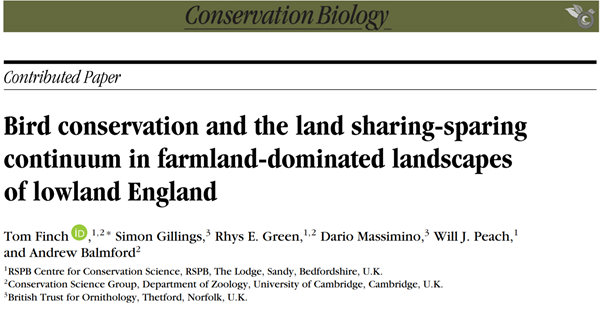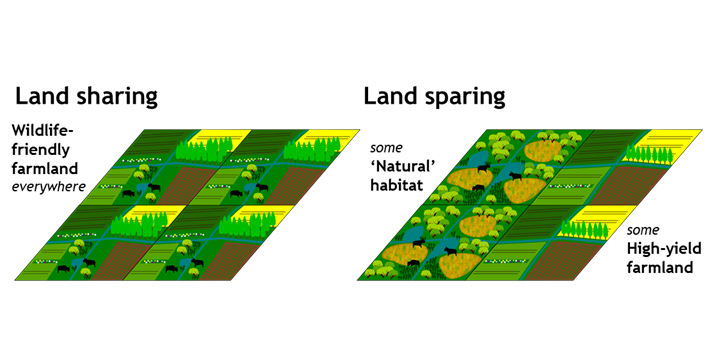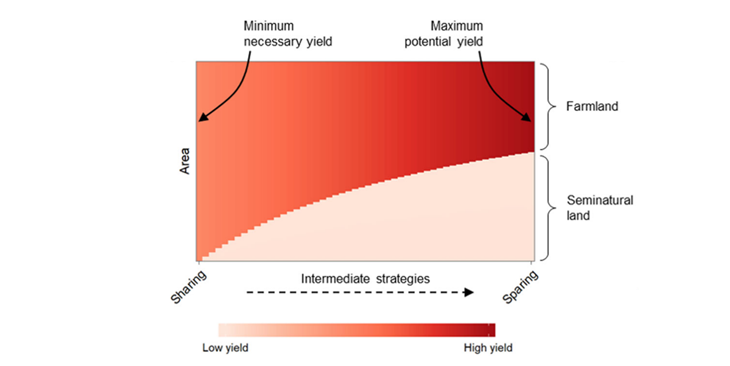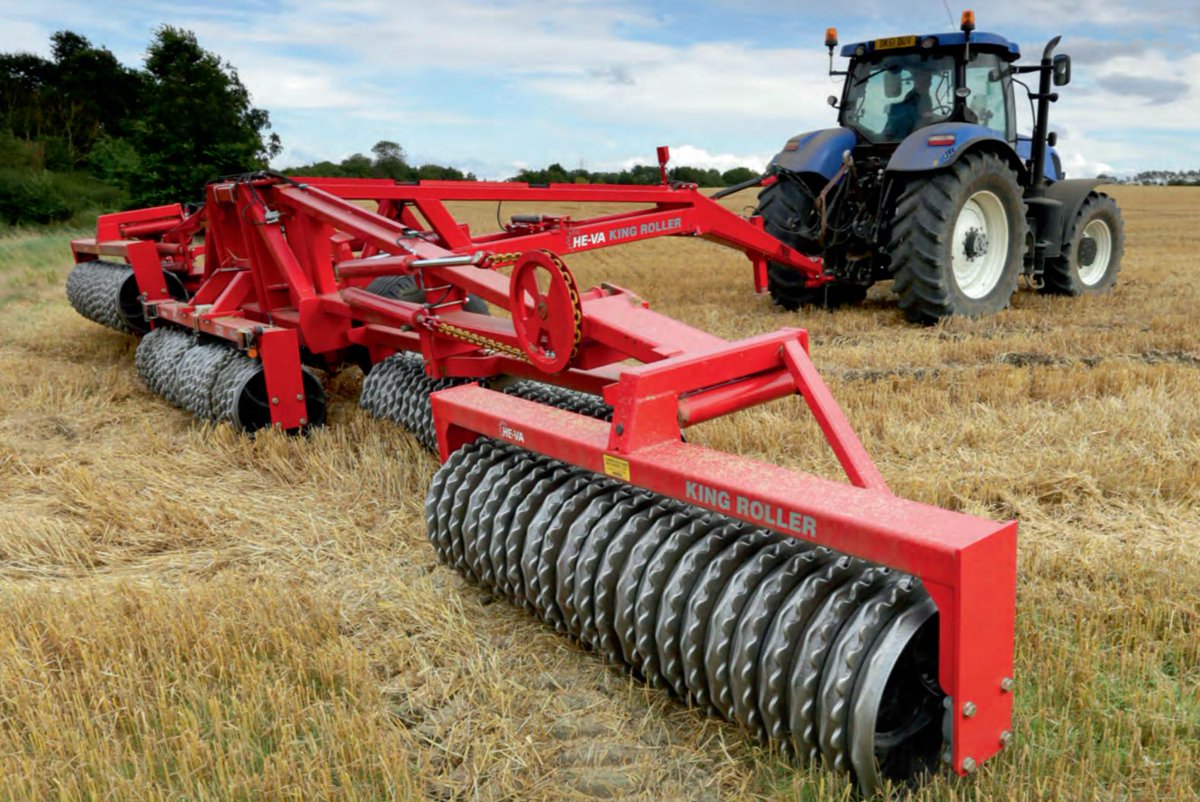New paper! #conservation #ornithology #agriculture  https://abs.twimg.com/emoji/v2/... draggable="false" alt="🦆" title="Duck" aria-label="Emoji: Duck">
https://abs.twimg.com/emoji/v2/... draggable="false" alt="🦆" title="Duck" aria-label="Emoji: Duck"> https://abs.twimg.com/emoji/v2/... draggable="false" alt="🌳" title="Deciduous tree" aria-label="Emoji: Deciduous tree">
https://abs.twimg.com/emoji/v2/... draggable="false" alt="🌳" title="Deciduous tree" aria-label="Emoji: Deciduous tree"> https://abs.twimg.com/emoji/v2/... draggable="false" alt="🚜" title="Tractor" aria-label="Emoji: Tractor">
https://abs.twimg.com/emoji/v2/... draggable="false" alt="🚜" title="Tractor" aria-label="Emoji: Tractor">
Full text here (paywalled, sorry, I know. DM for pdf): https://onlinelibrary.wiley.com/doi/pdf/10.1111/cobi.13316">https://onlinelibrary.wiley.com/doi/pdf/1...
@RSPBScience blog here: https://community.rspb.org.uk/ourwork/b/biodiversity/posts/sparing-or-sharing
Thread">https://community.rspb.org.uk/ourwork/b... to follow...
1/
Full text here (paywalled, sorry, I know. DM for pdf): https://onlinelibrary.wiley.com/doi/pdf/10.1111/cobi.13316">https://onlinelibrary.wiley.com/doi/pdf/1...
@RSPBScience blog here: https://community.rspb.org.uk/ourwork/b/biodiversity/posts/sparing-or-sharing
Thread">https://community.rspb.org.uk/ourwork/b... to follow...
1/
Agriculture often causes wildlife declines, but is crucial for feeding the (growing) human population.
Should we share food production & nature conservation on wildlife-friendly farmland, or spare bigger units of natural/semi-natural land by farming at higher yields?
2/
Should we share food production & nature conservation on wildlife-friendly farmland, or spare bigger units of natural/semi-natural land by farming at higher yields?
2/
We compared sparing and sharing in 2 regions of England.
We used density-yield curves to predict the breeding density (across 1-km squares) of each species in nature reserves and in farmland covering the full gradient of agricultural yield
3/
We used density-yield curves to predict the breeding density (across 1-km squares) of each species in nature reserves and in farmland covering the full gradient of agricultural yield
3/
We then estimated the total regional population size of each bird species (101 in The Fens, 83 in Salisbury Plain) across the continuum from land sharing to land sparing.
Each strategy produces the same total quantity of food https://abs.twimg.com/emoji/v2/... draggable="false" alt="⚖️" title="Scales" aria-label="Emoji: Scales">
https://abs.twimg.com/emoji/v2/... draggable="false" alt="⚖️" title="Scales" aria-label="Emoji: Scales">
4/
Each strategy produces the same total quantity of food
4/
So, which is best: sharing or sparing?
We asked this question by testing which strategy resulted in the greatest relative population size, averaged across all species within each region.
5/
We asked this question by testing which strategy resulted in the greatest relative population size, averaged across all species within each region.
5/
Plot twist: both sharing and sparing were almost always beaten by *something else*
Here, each coloured line represents a different strategy. Overall food production increases L>R and mean bird population size increases bottom>top.
The purple line is always (close to) best
6/
Here, each coloured line represents a different strategy. Overall food production increases L>R and mean bird population size increases bottom>top.
The purple line is always (close to) best
6/
The purple line (prev. tweet) represents ‘three-compartment’ sparing, so-called because it combines [1] high-yield farmland + [2] + semi/natural habitat [3] low-yield farmland
= food https://abs.twimg.com/emoji/v2/... draggable="false" alt="✅" title="White heavy check mark" aria-label="Emoji: White heavy check mark"> nature-reserve-preferring birds
https://abs.twimg.com/emoji/v2/... draggable="false" alt="✅" title="White heavy check mark" aria-label="Emoji: White heavy check mark"> nature-reserve-preferring birds  https://abs.twimg.com/emoji/v2/... draggable="false" alt="✅" title="White heavy check mark" aria-label="Emoji: White heavy check mark"> farmland-preferring birds
https://abs.twimg.com/emoji/v2/... draggable="false" alt="✅" title="White heavy check mark" aria-label="Emoji: White heavy check mark"> farmland-preferring birds  https://abs.twimg.com/emoji/v2/... draggable="false" alt="✅" title="White heavy check mark" aria-label="Emoji: White heavy check mark">
https://abs.twimg.com/emoji/v2/... draggable="false" alt="✅" title="White heavy check mark" aria-label="Emoji: White heavy check mark">
7/
= food
7/
Caveat 1: high-yield farming won’t automatically spare land for conservation. Policies are need to link the two
See here for some examples: http://dx.doi.org/10.1126/science.aad0055
I">https://dx.doi.org/10.1126/s... like this too: http://dx.doi.org/10.1111/cobi.12046
8/">https://dx.doi.org/10.1111/c...
See here for some examples: http://dx.doi.org/10.1126/science.aad0055
I">https://dx.doi.org/10.1126/s... like this too: http://dx.doi.org/10.1111/cobi.12046
8/">https://dx.doi.org/10.1111/c...
Caveat 2: high-yield farming must be sustainable / resilient, which might mean forgoing some productivity in the near-term.
But see here for a counterpoint to the argument that higher-yield practices inherently incur larger negative externalities: https://dx.doi.org/10.1038/s41893-018-0138-5
9/">https://dx.doi.org/10.1038/s...
But see here for a counterpoint to the argument that higher-yield practices inherently incur larger negative externalities: https://dx.doi.org/10.1038/s41893-018-0138-5
9/">https://dx.doi.org/10.1038/s...
Caveat 3: high-yield farming needn’t be devoid of wildlife; some species can do well even in high-yield farmland.
This is the aim at RSPB& #39;s Hope Farm: https://www.rspb.org.uk/our-work/conservation/conservation-and-sustainability/farming/hope-farm/">https://www.rspb.org.uk/our-work/...
But we need to be careful that conservation efforts don’t export demand for food elsewhere.
10/
This is the aim at RSPB& #39;s Hope Farm: https://www.rspb.org.uk/our-work/conservation/conservation-and-sustainability/farming/hope-farm/">https://www.rspb.org.uk/our-work/...
But we need to be careful that conservation efforts don’t export demand for food elsewhere.
10/
Summary: To maximise the area of land managed largely for conservation (semi/natural habitat + high nature value farmland)...
Whilst still delivering food for people...
We’ll also need specialised (but sustainable) farmland. Productive agriculture is important!
11/
Whilst still delivering food for people...
We’ll also need specialised (but sustainable) farmland. Productive agriculture is important!
11/
See also: this @JAppliedEcology paper, in which we tested some UK-wide sparing scenarios + demand reduction.
Combining supply- and demand-side measures could result in big wins for UK birds ( http://dx.doi.org/10.1111/1365-2664.13362),">https://dx.doi.org/10.1111/1... and carbon too ( http://dx.doi.org/10.1038/nclimate2910)
12/12">https://dx.doi.org/10.1038/n...
Combining supply- and demand-side measures could result in big wins for UK birds ( http://dx.doi.org/10.1111/1365-2664.13362),">https://dx.doi.org/10.1111/1... and carbon too ( http://dx.doi.org/10.1038/nclimate2910)
12/12">https://dx.doi.org/10.1038/n...

 Read on Twitter
Read on Twitter https://abs.twimg.com/emoji/v2/... draggable="false" alt="🌳" title="Deciduous tree" aria-label="Emoji: Deciduous tree">https://abs.twimg.com/emoji/v2/... draggable="false" alt="🚜" title="Tractor" aria-label="Emoji: Tractor">Full text here (paywalled, sorry, I know. DM for pdf): https://onlinelibrary.wiley.com/doi/pdf/1... @RSPBScience blog here: https://community.rspb.org.uk/ourwork/b... to follow...1/" title="New paper! #conservation #ornithology #agriculture https://abs.twimg.com/emoji/v2/... draggable="false" alt="🦆" title="Duck" aria-label="Emoji: Duck">https://abs.twimg.com/emoji/v2/... draggable="false" alt="🌳" title="Deciduous tree" aria-label="Emoji: Deciduous tree">https://abs.twimg.com/emoji/v2/... draggable="false" alt="🚜" title="Tractor" aria-label="Emoji: Tractor">Full text here (paywalled, sorry, I know. DM for pdf): https://onlinelibrary.wiley.com/doi/pdf/1... @RSPBScience blog here: https://community.rspb.org.uk/ourwork/b... to follow...1/" class="img-responsive" style="max-width:100%;"/>
https://abs.twimg.com/emoji/v2/... draggable="false" alt="🌳" title="Deciduous tree" aria-label="Emoji: Deciduous tree">https://abs.twimg.com/emoji/v2/... draggable="false" alt="🚜" title="Tractor" aria-label="Emoji: Tractor">Full text here (paywalled, sorry, I know. DM for pdf): https://onlinelibrary.wiley.com/doi/pdf/1... @RSPBScience blog here: https://community.rspb.org.uk/ourwork/b... to follow...1/" title="New paper! #conservation #ornithology #agriculture https://abs.twimg.com/emoji/v2/... draggable="false" alt="🦆" title="Duck" aria-label="Emoji: Duck">https://abs.twimg.com/emoji/v2/... draggable="false" alt="🌳" title="Deciduous tree" aria-label="Emoji: Deciduous tree">https://abs.twimg.com/emoji/v2/... draggable="false" alt="🚜" title="Tractor" aria-label="Emoji: Tractor">Full text here (paywalled, sorry, I know. DM for pdf): https://onlinelibrary.wiley.com/doi/pdf/1... @RSPBScience blog here: https://community.rspb.org.uk/ourwork/b... to follow...1/" class="img-responsive" style="max-width:100%;"/>


 4/" title="We then estimated the total regional population size of each bird species (101 in The Fens, 83 in Salisbury Plain) across the continuum from land sharing to land sparing.Each strategy produces the same total quantity of food https://abs.twimg.com/emoji/v2/... draggable="false" alt="⚖️" title="Scales" aria-label="Emoji: Scales">4/" class="img-responsive" style="max-width:100%;"/>
4/" title="We then estimated the total regional population size of each bird species (101 in The Fens, 83 in Salisbury Plain) across the continuum from land sharing to land sparing.Each strategy produces the same total quantity of food https://abs.twimg.com/emoji/v2/... draggable="false" alt="⚖️" title="Scales" aria-label="Emoji: Scales">4/" class="img-responsive" style="max-width:100%;"/>

![White heavy check mark The purple line (prev. tweet) represents ‘three-compartment’ sparing, so-called because it combines [1] high-yield farmland + [2] + semi/natural habitat [3] low-yield farmland= food https://abs.twimg.com/emoji/v2/... draggable=](https://pbs.twimg.com/media/D3xXMkzX4AAicvg.png) nature-reserve-preferring birds https://abs.twimg.com/emoji/v2/... draggable="false" alt="✅" title="White heavy check mark" aria-label="Emoji: White heavy check mark"> farmland-preferring birds https://abs.twimg.com/emoji/v2/... draggable="false" alt="✅" title="White heavy check mark" aria-label="Emoji: White heavy check mark">7/" title="The purple line (prev. tweet) represents ‘three-compartment’ sparing, so-called because it combines [1] high-yield farmland + [2] + semi/natural habitat [3] low-yield farmland= food https://abs.twimg.com/emoji/v2/... draggable="false" alt="✅" title="White heavy check mark" aria-label="Emoji: White heavy check mark"> nature-reserve-preferring birds https://abs.twimg.com/emoji/v2/... draggable="false" alt="✅" title="White heavy check mark" aria-label="Emoji: White heavy check mark"> farmland-preferring birds https://abs.twimg.com/emoji/v2/... draggable="false" alt="✅" title="White heavy check mark" aria-label="Emoji: White heavy check mark">7/" class="img-responsive" style="max-width:100%;"/>
nature-reserve-preferring birds https://abs.twimg.com/emoji/v2/... draggable="false" alt="✅" title="White heavy check mark" aria-label="Emoji: White heavy check mark"> farmland-preferring birds https://abs.twimg.com/emoji/v2/... draggable="false" alt="✅" title="White heavy check mark" aria-label="Emoji: White heavy check mark">7/" title="The purple line (prev. tweet) represents ‘three-compartment’ sparing, so-called because it combines [1] high-yield farmland + [2] + semi/natural habitat [3] low-yield farmland= food https://abs.twimg.com/emoji/v2/... draggable="false" alt="✅" title="White heavy check mark" aria-label="Emoji: White heavy check mark"> nature-reserve-preferring birds https://abs.twimg.com/emoji/v2/... draggable="false" alt="✅" title="White heavy check mark" aria-label="Emoji: White heavy check mark"> farmland-preferring birds https://abs.twimg.com/emoji/v2/... draggable="false" alt="✅" title="White heavy check mark" aria-label="Emoji: White heavy check mark">7/" class="img-responsive" style="max-width:100%;"/>




